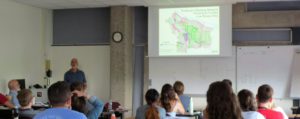Course Day 3: Portland Cycling Planning Lessons from Roger Geller
Roger Geller, one of the PSU instructors, gave his lecture on Wednesday on “The Making of the Bike Friendly City.” Portland has several conditions that support cycling infrastructure before that was even a consideration. Good mixed-land use and flat land created ideal conditions to create a cycling network. As Roger said, “when it comes to bike use, land use is destiny.”
There were also five more conditions he saw as essential to creating a bicycling city like Portland.
- Supportive Policies
- Funding
- Political Leadership
- Innovative Professionals (in many different areas)
- Effective Advocacy
I also consider Vancouver a bicycle-friendly city and can see all of these conditions at play in the city currently. Our connected long-term plans from Greenest City to Renewable City to Healthy City make it easy for city staff to direct their planning toward these goals and strategies which cycling fits well into. Vancouver also has a City Council that is pushing (and providing funding) for cycling infrastructure and related programs like Modi. HUB and BEST (our main cycling advocacy organizations) are also doing great things and I think all this has created room for private companies and non-profits to expand their cycling-related services and products.
During his talk and many of the other lectures, I noticed that a cohesive, comprehensive network has come up many times. In Vancouver, I think the City is really trying to push this with the “spot improvement” program and HUB’s #ungapthemap is a good compliment to further encourage the city. These cohesive network concept all seems to link back to the Netherland’s CROW manual (and Sustainable Safety).
I think Roger’s take home message was that knowing how to build infrastructure is not very useful with the political and policy context doesn’t support it. Engineers need to push for infrastructure from their side and planners and decision makers need to push from their side with supportive policies. As planners, we need to support and work with engineers to try new infrastructure interventions and push ourselves to find out what works in the cities we practice in. We need to create policies that clearly links to outcomes so it is easy for politicians to get on board and support a transportation network that makes us healthier, happier and more resilient.
As Roger said, “Policy leads to investment leads to desired outcomes.”
